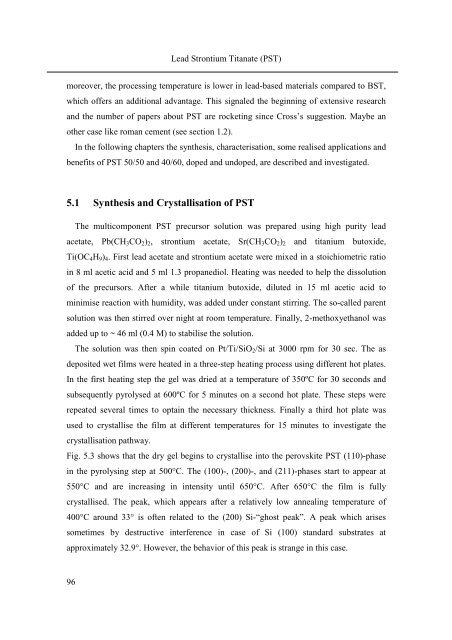PhD Thesis Arne Lüker final version V4 - Cranfield University
PhD Thesis Arne Lüker final version V4 - Cranfield University
PhD Thesis Arne Lüker final version V4 - Cranfield University
You also want an ePaper? Increase the reach of your titles
YUMPU automatically turns print PDFs into web optimized ePapers that Google loves.
96<br />
Lead Strontium Titanate (PST)<br />
moreover, the processing temperature is lower in lead-based materials compared to BST,<br />
which offers an additional advantage. This signaled the beginning of extensive research<br />
and the number of papers about PST are rocketing since Cross’s suggestion. Maybe an<br />
other case like roman cement (see section 1.2).<br />
In the following chapters the synthesis, characterisation, some realised applications and<br />
benefits of PST 50/50 and 40/60, doped and undoped, are described and investigated.<br />
5.1 Synthesis and Crystallisation of PST<br />
The multicomponent PST precursor solution was prepared using high purity lead<br />
acetate, Pb(CH3CO2)2, strontium acetate, Sr(CH3CO2)2 and titanium butoxide,<br />
Ti(OC4H9)4. First lead acetate and strontium acetate were mixed in a stoichiometric ratio<br />
in 8 ml acetic acid and 5 ml 1.3 propanediol. Heating was needed to help the dissolution<br />
of the precursors. After a while titanium butoxide, diluted in 15 ml acetic acid to<br />
minimise reaction with humidity, was added under constant stirring. The so-called parent<br />
solution was then stirred over night at room temperature. Finally, 2-methoxyethanol was<br />
added up to ~ 46 ml (0.4 M) to stabilise the solution.<br />
The solution was then spin coated on Pt/Ti/SiO2/Si at 3000 rpm for 30 sec. The as<br />
deposited wet films were heated in a three-step heating process using different hot plates.<br />
In the first heating step the gel was dried at a temperature of 350ºC for 30 seconds and<br />
subsequently pyrolysed at 600ºC for 5 minutes on a second hot plate. These steps were<br />
repeated several times to optain the necessary thickness. Finally a third hot plate was<br />
used to crystallise the film at different temperatures for 15 minutes to investigate the<br />
crystallisation pathway.<br />
Fig. 5.3 shows that the dry gel begins to crystallise into the perovskite PST (110)-phase<br />
in the pyrolysing step at 500°C. The (100)-, (200)-, and (211)-phases start to appear at<br />
550°C and are increasing in intensity until 650°C. After 650°C the film is fully<br />
crystallised. The peak, which appears after a relatively low annealing temperature of<br />
400°C around 33° is often related to the (200) Si-“ghost peak”. A peak which arises<br />
sometimes by destructive interference in case of Si (100) standard substrates at<br />
approximately 32.9°. However, the behavior of this peak is strange in this case.

















